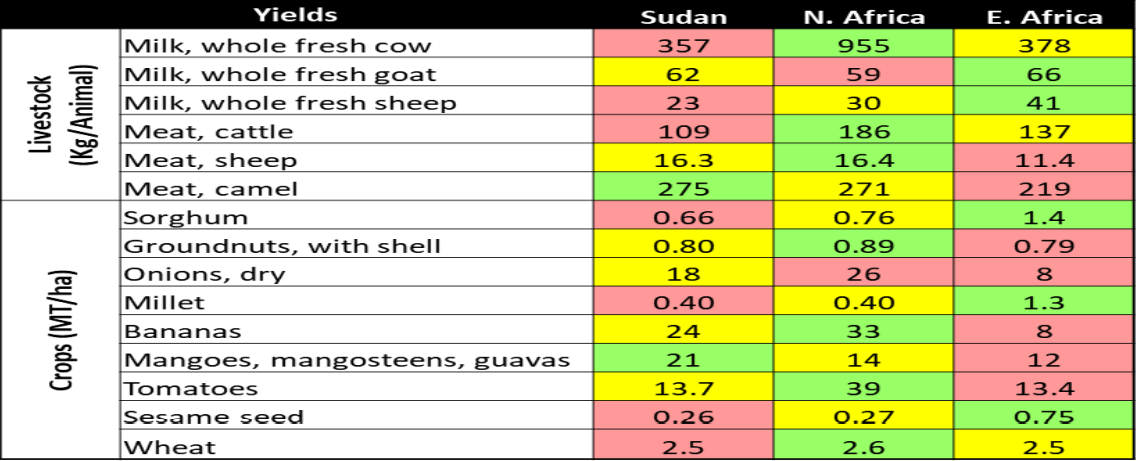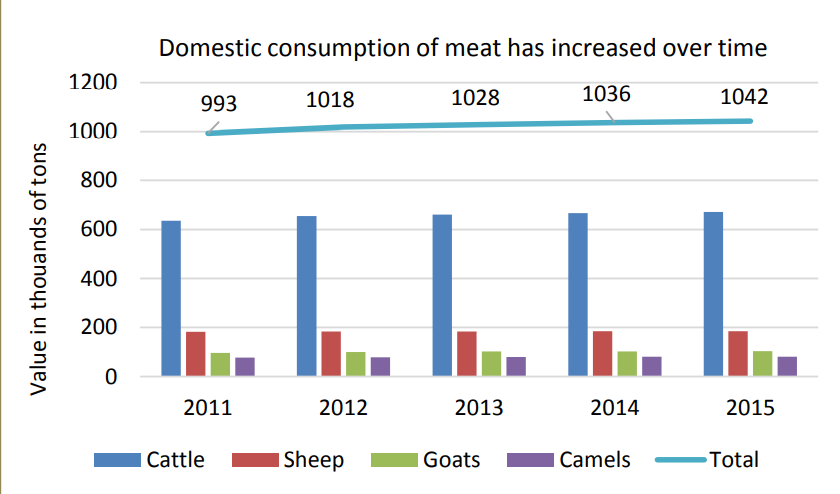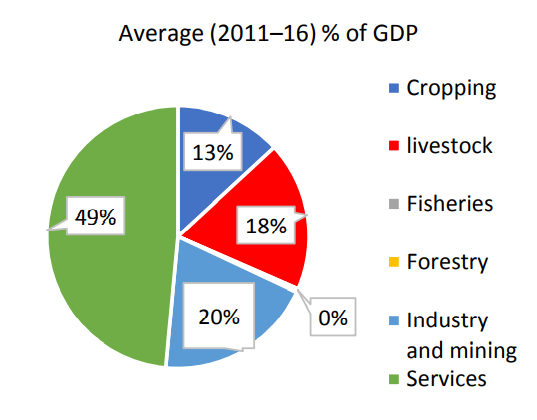Introduction
Meat supply is important for the economies of Eastern Africa and Sudan in particular. Aside from oil, agriculture is the most important Sudanese industry, encompassing the majority of the country’s workforce (Wilson, 2018). However, despite its significance, the supply chain has numerous weaknesses that have been exposed in recent years. Consumption of meat is only likely to increase, which necessitates attention toward the agricultural industry (World Bank Group, 2020). Understanding what aspects make the supply chain vulnerable is essential in ascertaining solutions and recommendations that would strengthen it.
Challenges
Inadequate Workforce
The first challenge is insufficient quality and quantity of the workforce that is responsible for meat production, processing and distribution. The structure of the Sudanese agricultural industry presupposes a large percentage of smallholder farmers, who are individually responsible for livestock safety and nutrition (Food and Agriculture Organization of the United Nations, 2021). Furthermore, most of them are nomadic pastoralists – herders who constantly travel between pastures looking for favorable conditions. Such a form of pastoralism is known as transhumance, which is usually driven by seasonal changes (Onah et al., 2020). Agricultural systems based on transhumance movements are not effective since a substantial amount of time is spent on moving livestock from one pasture to another.
The already vulnerable industry has been further impacted by COVID-related restrictions. Quarantine measures aimed at alleviating the threat of contamination have led to the shutdown of many meat plants (Ijaz et al., 2021). The reason for this change lies in the necessity of physical work – slaughter work has to be managed by workers. The fewer people in the workforce available, the less meat can be produced. The industry shrunk as a wave of layoffs and reduction in wages decreased the number of working people (Ijaz et al., 2021). Not only was meat production reduced, but meat processing and distribution were also negatively impacted.
As a result, the meat supply chain suffers due to the reliance of the industry on pastoralists and the onslaught of the pandemic. Governmental investments in research and development in this sphere are limited (Food and Agriculture Organization of the United Nations, 2021). Most of the activities are semi-mechanized or performed by workers themselves (Baudron, 2019). As the pandemic has showcased, this form of labor organization is extremely vulnerable to any outside influences. Combined with the quarantine measures, a reduction in wages leads to substantial labor shortages across the industry (World Bank Group, 2020). Subsequently, productivity is low, and the livestock industry experiences difficulties with supplying the domestic demand with sufficient meat.
Insufficient Output Opportunities
The second challenge is the lack of opportunities for the industry to sell its produce. The industry has experienced a decline in income from all sources. Many businesses were forced to abandon some expensive products and euthanize animals due to the inability to provide adequate resources for processing (Ijaz et al., 2021). Meanwhile, smallholder producers lack access to market data, such as prices in different locations and other output options, including exporting to foreign markets (World Bank Group, 2020). At the same time, Sudan’s yield in meat is lower than in countries of Northern and Eastern Africa, as shown on Figure 1. As a result, producers are reliant on limited channels, which can easily be cut off by external forces such as quarantine measures and political instability.

Furthermore, the logistics of the supply chain can also become easily compromised. Pandemic-related movement restrictions have also led to an increase in transportation costs (Food and Agriculture Organization of the United Nations, 2021). The subsequent implication is that smallholder producers are forced to reduce their movement and economic activities. Containment measures had a direct impact on trading, the scale of which has also decreased. Trade disruptions further curtail the number of output opportunities, which are already in deficit. The low amount of trade implies a decrease in meat supply, which is a principal commodity for Sudanese citizens, the prominence of which has only risen with time, as Figure 2 shows.

Another output issue stems from the consumers’ inability to buy the product. The growing inflation and increasing prices have reduced purchasing abilities of customers. Labor shortage signifies the lack of opportunities to earn money among the population. Unable to sell meat, producers are left with products that cannot bring them profit and depreciate in value due to the limited lifespan of meat. Meanwhile, farmers are forced to keep the prices high due to high costs, which are necessary to produce meat and present it on the market. As a result, the supply chain allows meat to appear in the stores, but customers lack the financial capacity to buy it.
Animal Health
The third challenge is the state of livestock health, which is not always adequate. It is a complex problem that is intrinsically connected with the provision of adequate feed. The quality of meat is directly linked to the welfare of animals from which meat is produced. As the industry mostly consists of smallholder farmers, the majority of livestock does not receive adequate nutrition (El-Sammani et al., 2019). Many producers do not have the resources to ensure high-quality feed due to the high expense of credits and limited governmental support (World Bank Group, 2020). Without it, farmers are not able to provide sufficient care for livestock.
The quality of animal feed has a direct impact on the meat products available on the market. Most of the animals survive by eating grass and plants. However, in order to obtain a large amount of marketable meat, it is necessary to provide cattle with substantial input of protein. Meanwhile, it is a common practice among Sudanese pastoralists to use feed saturated with alfalfa and sorghum (World Bank Group, 2020). Not only does it not allow for livestock fattening, but it is also harmful to humans since carcinogenic aflatoxins are not properly processed by the human digestive system (World Bank Group, 2020). As a result, the supply chain provides consumers with low-quality and potentially harmful produce.
Another aspect influencing animal health is the threat of diseases. One of the sources of livestock feed is plants, which can transmit diseases. Many plants in Sudan are characterized by the presence of fall armyworms and numerous locust infestations (Food and Agriculture Organization of the United Nations, 2021). When cattle consume the affected plants, they expose themselves to parasites, which cause diseases. Special attention is given to two particular diseases: peste des petits ruminants and hemorrhagic septicaemia (Food and Agriculture Organization of the United Nations, 2021). Both of them contribute to livestock mortality, which can be prevented with adequate veterinary care. However, access to such medicine is limited to such a point that no control programs regulating livestock health are implemented in Sudan (World Bank Group, 2020). All subsequent outbreaks of infections are not contained, leading to high cattle mortality. As a consequence, the infestation of plants with parasites, animal diseases, and a deficit of veterinary services further weaken the Sudanese meat supply chain.
Lack of Land
The fourth challenge is the lack of land that is necessary for production and processing of meat. Livestock is an essential component of any economic activity involving animals. However, before animals and poultry can be processed into food, they have to be cared for in livelihoods. It is estimated that there are more than 40 million cattle, fifty million sheep, 40 million goats, 4 million camels, 7 million donkeys and 700 thousand horses in Sudan (Wilson, 2018). It is evident that maintaining such a high number of animals necessitates large expanses of physical space where the livestock can be fed.
However, the governmental policy regarding the use of land is disproportionate to the importance of industries. Two particular industries are prioritized over the meat processing industry in this regard – oil and crop production. The production of oil has a destructive effect on pastoral livelihoods since the soil is contaminated and is no longer fertile (Wilson, 2018). Meanwhile, crop production is also a space-demanding activity requiring large expanses of land. The expansion of crop production is extensive in nature which transpires at the expense of livelihoods designed for meat production. As a result, the land that is necessary for meat production is repurposed for other industries to the detriment of the meat supply.
Yet, the lack of pasture also stems from climatic conditions, which are also influenced by the government. Sudan’s geography determines inhospitable weather that manifests itself in rains and droughts. Periods of heavy rain lead to floods that destroy infrastructure, cropland, and pastures (World Bank Group, 2020). The processes of deforestation and desertification strip the meat producers from access to pastures and water. Subsequently, transhumance pastoralists are forced to use a limited number of cattle routes. COVID-related measures also restricted livestock movement, further limiting pastoralists’ flexibility. As a consequence, large quantities of animal breeders became concentrated in limited spaces, prompting conflicts among them. The inhospitable climate further curtails meat production opportunities and weakens the supply chain.
Solutions
Producer Groups
The first solution is to centralize the meat production industry. Most of the farmers are individual owners of smallholder farms that lack the technology and finances to advance meet production. Meanwhile, pastoralists rely on farming areas for maintaining cattle feed. Organizing them into centralized producer groups will improve their efficiency (Wilson, 2018; World Bank Group, 2020). First, such unions will combine their resources and divide costs between each other. Such expenditures as transportation costs will become less taxing due to the ability of producer groups to contact policymakers and ask for exemptions for the transportation of meat, which is essential for Sudanese consumption (Ijaz et al., 2021). Smallholder producers have no such opportunity and are forced to manage high costs on their own.
Second, producer groups will be able to attract finances from both domestic and foreign sources. Credit is not a viable option for individual farmers since it is too expensive (El-Sammani et al., 2019). However, the cumulative efforts by numerous producers are more capable of realizing business potential, which raises their attractiveness for banks. Furthermore, such groups can attract governmental funding via participation in grant programs. Meanwhile, on the foreign market, the demand for meat of Sudanese local breeds presents a lucrative business opportunity (Food and Agriculture Organization of the United Nations, 2021). The status of a producer group facilitates the process of finding partners compared to smallholder farmers.
Animal Health Initiatives
The second solution is to channel governmental efforts into improving the health and conditions of livestock. It is essential to ensure the sufficient quality of animal feed to reduce the risk of diseases (Rojas-Downing et al., 2017). Research suggests that crops can be treated with urea and sodium hydroxide to increase their nutritional quality (Wilson, 2018). Adding protein into feed precipitates cattle fattening, which implies bigger meat products. Ensuring access to surface water is also essential in preventing cattle dehydration and keeping the livestock in a healthy state. Overall, it is important to organize training for pastoralists and farmers who need to know the specifics of animal feed.
However, when diseases do occur, there is the need to have accessible veterinary services. The government can implement standards for economic activities in the agricultural industry, which are notably missing from Sudan (World Bank Group, 2020). One such standard could require each producer group to include regular veterinary observation of livestock. Such a requirement would necessitate the availability of veterinarians in the proximity of herds. Ensuring that such standards are introduced requires the involvement of policymakers who can be persuaded to improve the quality of livestock, which is essential for the functioning of meat supply chain.
Land Management
The third solution is to develop a balanced land management system that would ensure that the needs for space are satisfied in all industries. A major challenge that prevents herders from remaining in one place is the necessity to change pastures. The industry needs to implement mechanized farming, which would decrease human input (World Bank Group, 2020). Furthermore, implementing quota-based distribution of land would ensure that all industries are afforded the territories that correspond to the role of each industry in the country’s GDP, which is shown on Figure 3. Combined with technological innovations, the distribution of land would streamline the functioning of the industry and ensure fair responsibility among meat producers.

Conclusion
Altogether, it should be evident that Sudan has large potential and numerous problems in its meat supply chain. Most of the issues stem from the traditional organization of livestock management, which is not effective. Meanwhile, the absence of governmental regulation leads to low quality of livestock’s health and conflicts in land distribution. Encouraging the formation of producer groups will help farmers and pastoralists overcome financial challenges, while governmental regulation will improve the quality of meat and proper land distribution between industries.
Recommendations
The first recommendation is to intensify communication with policymakers and accentuate the importance of a functioning supply chain for the consumption of meat. The second recommendation is to set up training programs that would educate pastoralists on the matters of cattle health and parasites among plants. The third recommendation is to invest in technological innovations to increase the proportion of mechanized activities. The fourth recommendation is to reach out to foreign partners that would be interested in buying Sudanese meat.
References
Baudron, F., Misiko, M., Getnet, B., Nazare, R., Sariah, J., & Kaumbutho, P. (2019). A farm-level assessment of labor and mechanization in Eastern and Southern Africa.Agronomy for Sustainable Development, 39(2), 1-13. Web.
El-Sammani, M. A. H., Babiker, B. I., & Ahmed, A. H. (2019). Competitiveness of the Sudan live sheep exports in the Saudi Market. University of Khartoum Journal of Agricultural Sciences, 27. 66-80. Web.
Food and Agriculture Organization of the United Nations. (2021). The Sudan | Agricultural livelihoods and food security in the context of COVID-19. Web.
Ijaz, M., Yar, M. K., Badar, I. H., Ali, S., Islam, M. S., Jaspal, M. H., & Guevara-Ruiz, D. (2021). Meat production and supply chain under COVID-19 scenario: Current trends and future prospects. Frontiers in Veterinary Science, 8(660736), 1-10.
Onah, O., Akarugwo, A. E., Okeke, N. A., & Nwakile, T. C. (2020). Climate change and transhumance pastoralism in North-Central Nigeria. International Journal of Multidisciplinary and Current Research, 8, 409-414.
Rojas-Downing, M. M., Nejadhashemi, A. P., Harrigan, T., & Woznicki, S. A. (2017). Climate change and livestock: Impacts, adaptation, and mitigation. Climate Risk Management, 16, 145-163.
Wilson, R. T. (2018). Livestock in the Republic of Sudan: Policies, production, problems and possibilities. Animal Husbandry, Dairy and Veterinary Science, 2(3), 1-12.
World Bank Group. (2020). Sudan agriculture value chain analysis. Web.